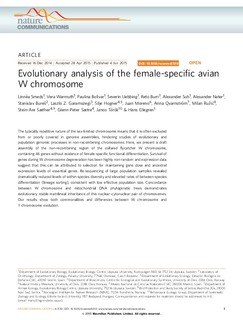| dc.contributor.author | Smeds, Linnea | |
| dc.contributor.author | Warmuth, Vera | |
| dc.contributor.author | Bolivar, Paulina | |
| dc.contributor.author | Uebbing, Severin | |
| dc.contributor.author | Burri, Reto | |
| dc.contributor.author | Suh, Alexander | |
| dc.contributor.author | Nater, Alexander | |
| dc.contributor.author | Bures, Stanislav | |
| dc.contributor.author | Garamszegi, Laszlo Z. | |
| dc.contributor.author | Hogner, Silje | |
| dc.contributor.author | Moreno, Juan | |
| dc.contributor.author | Qvarnström, Anna | |
| dc.contributor.author | Ruzic, Milan | |
| dc.contributor.author | Sæther, Stein Are | |
| dc.contributor.author | Sætre, Glenn-Peter | |
| dc.contributor.author | Torok, Janos | |
| dc.contributor.author | Ellegren, Hans | |
| dc.date.accessioned | 2015-07-02T09:07:03Z | |
| dc.date.accessioned | 2016-07-15T10:56:30Z | |
| dc.date.available | 2015-07-02T09:07:03Z | |
| dc.date.available | 2016-07-15T10:56:30Z | |
| dc.date.issued | 2015 | |
| dc.identifier.citation | Nature Communications 2015, 6 | nb_NO |
| dc.identifier.issn | 2041-1723 | |
| dc.identifier.uri | http://hdl.handle.net/11250/2396624 | |
| dc.description.abstract | The typically repetitive nature of the sex-limited chromosome means that it is often excluded
from or poorly covered in genome assemblies, hindering studies of evolutionary and
population genomic processes in non-recombining chromosomes. Here, we present a draft
assembly of the non-recombining region of the collared flycatcher W chromosome,
containing 46 genes without evidence of female-specific functional differentiation. Survival of
genes during Wchromosome degeneration has been highly non-random and expression data
suggest that this can be attributed to selection for maintaining gene dose and ancestral
expression levels of essential genes. Re-sequencing of large population samples revealed
dramatically reduced levels of within-species diversity and elevated rates of between-species
differentiation (lineage sorting), consistent with low effective population size. Concordance
between W chromosome and mitochondrial DNA phylogenetic trees demonstrates
evolutionary stable matrilineal inheritance of this nuclear–cytonuclear pair of chromosomes.
Our results show both commonalities and differences between W chromosome and
Y chromosome evolution. | nb_NO |
| dc.language.iso | eng | nb_NO |
| dc.rights | Navngivelse-DelPåSammeVilkår 3.0 Norge | * |
| dc.rights | Navngivelse-Ikkekommersiell-DelPåSammeVilkår 3.0 Norge | * |
| dc.rights.uri | http://creativecommons.org/licenses/by-nc-sa/3.0/no/ | * |
| dc.title | Evolutionary analysis of the female-specific avianW chromosome | nb_NO |
| dc.type | Journal article | nb_NO |
| dc.type | Peer reviewed | nb_NO |
| dc.date.updated | 2015-07-02T09:07:03Z | |
| dc.source.volume | 6 | nb_NO |
| dc.source.journal | Nature Communications | nb_NO |
| dc.identifier.doi | 10.1038/ncomms8330 | |
| dc.identifier.cristin | 1252129 | |

